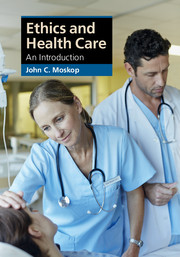Book contents
- Frontmatter
- Dedication
- Contents
- Preface
- Acknowledgment
- Part I Ethics in health care: role, history, and methods
- Part II Moral foundations of the therapeutic relationship
- Part III Controversies in health care ethics: treatment choices at the beginning and at the end of life
- Part IV Ethics in special contexts: biomedical research, genetics, and organ transplantation
- 19 Research on human subjects
- 20 The genetic revolution
- 21 Organ transplantation
- Further reading
- References
- Index
- References
19 - Research on human subjects
from Part IV - Ethics in special contexts: biomedical research, genetics, and organ transplantation
Published online by Cambridge University Press: 05 February 2016
- Frontmatter
- Dedication
- Contents
- Preface
- Acknowledgment
- Part I Ethics in health care: role, history, and methods
- Part II Moral foundations of the therapeutic relationship
- Part III Controversies in health care ethics: treatment choices at the beginning and at the end of life
- Part IV Ethics in special contexts: biomedical research, genetics, and organ transplantation
- 19 Research on human subjects
- 20 The genetic revolution
- 21 Organ transplantation
- Further reading
- References
- Index
- References
Summary
Case example
Mr. Simpson, a high school biology teacher, is a community member of the Institutional Review Board (IRB) at University Medical Center (UMC), the nearby academic medical center. (US federal regulations require that health care institutions establish IRBs to review and approve all publicly funded biomedical research on human subjects conducted at the institution.) At today's meeting of the UMC IRB, members are considering a research proposal entitled “Angina Pain Relief and Outcome Network Study,” or APRONS. Dr. Russell, Professor of Cardiology, explains that APRONS is a proposed multi-institution clinical trial of treatments for patients with stable coronary artery disease (narrowing of the arteries of the heart), and that he will be the lead investigator of this study at UMC. The study intends to enroll as research subjects more than 2000 patients with this condition over a period of three years. Patient-subjects will be randomly assigned to receive one of the following three interventions:
Optimal medical (drug) therapy to relieve angina (severe chest pain caused by inadequate blood supply to the heart) and to control progression of the disease.
Percutaneous coronary intervention (PCI), also called coronary angioplasty – a procedure in which a clinician feeds a catheter (a flexible tubular instrument) from an artery in the patient's leg through the blood vessels into an artery of the heart, then inflates a balloon to dilate that artery. When the balloon inflates, it implants an expandable wire mesh tubular device, called a stent, inside the artery. The expanded stent remains in the artery to keep it open. Subjects in this group will receive optimal drug therapy after PCI.
Sham PCI – a similar procedure in which a clinician feeds a catheter from an artery in the patient's leg through the blood vessels into an artery of the heart, but then removes the catheter without any additional intervention. Subjects in this group will receive optimal drug therapy after the sham procedure.
Patient-subjects in groups two and three will not be told which of the two procedures they have received until the study is completed. All study subjects will receive identical counseling and support for lifestyle changes to prevent disease progression, including smoking cessation, exercise, and diet.
- Type
- Chapter
- Information
- Ethics and Health CareAn Introduction, pp. 265 - 284Publisher: Cambridge University PressPrint publication year: 2016



